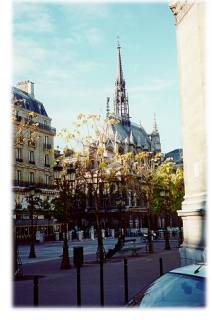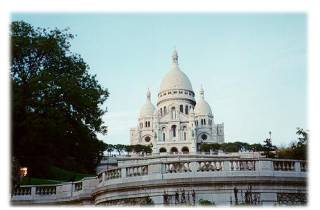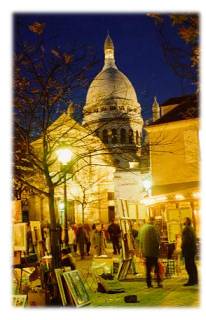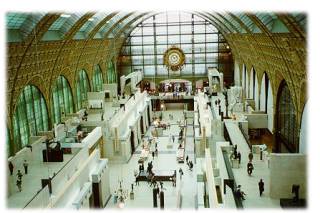|
On our first visit to Paris with students in 1984, we learned a great lesson about trip preparation when one of the students upon first visiting Notre Dame (after stops at Westminster, St. Paul's, Canterbury) exclaimed, "Another church??" We have learned to assume that there is no such thing as prior knowledge! Over the years we have seen Notre Dame in many states of repair and from many directions, but our favorite view remains the one from the rear. |

|

|
At Notre Dame long shots of the exterior are possible because of the open spaces around the church both in the front and the rear. Any random passerby on the Ile de la Cite can't help but see it in its full glory. But the exterior of the other great church on the Ile--maybe the most beautiful of France's 13th century works--is hidden from everyone by the courtyards surrounding it and the unknowing traveler gets to see only the steeple of Ste. Chapelle added hundreds of years later. But with determined effort that requires passing through metal detectors, one can get through to visit the interior and the real stars of the show: the stained glass windows. Ste. Chapelle was originally constructed to house Louis IX's most precious relic--the Crown of Thorns, but the relic has long since been moved to Notre Dame. Today, the great stained glass--the oldest in Paris--overwhelms even the most "churched-out" student who has ever visited Europe. The contrast between the bright upper royal chapel and the darker smaller lower chapel is a tremendous metaphor for the divisions in medieval society. |
|
Sacre Coeur sits atop the highest point in Paris at Montmartre. From miles away coming into Paris, one can see the outline of the Byzantine structure. The first time we saw it, Brenda loved it and I hated it; but over the years, I have come to like it a little better. The finished church was begun in 1873 after France's failure in the Franco-Prussian War and the subsequent uprising of the commune. One of the politicians at the time said that it was the symbol of civil war. Sacre Coeur was not finally finished and consecrated until the end of World War I. Today its steps rival the Trocadero as the leading fake Gucci market in Paris! |

|

|
On Montmartre, just a short distance from the Sacre Coeur, is the Place du Tertre, a small square that has gained great fame in paintings and stories of the Romantic Period when Montmartre itself was the home of the Bohemian lifestyle of the 19th century artist. Today, especially during the summer, the Place du Tertre is the symbol of the worst in art. The visitor cannot walk through the square without being accosted by dozens of portrait painters and caricaturists bargaining for a chance to turn out a work of art. If you'd like a souvenir, keep bargaining; the price can get very low. But for the most part, the most vaulable thing you have as a tourist in Paris is time, and there are much better places you can spend your precious minutes. On this trip, in November, on a cool night, we found few of the artists, few other tourists, and only four or five older neighborhood residents out for a walk. With some imagination, we were able to picture the square as it might have been a hundred years ago. |
|
The "Let's Go" guide to Paris describes the Musee d'Orsay as "art at is most accessible," and that's probably as good as description as one can have. Displaying paintings and sculpture from about 1840 to 1920, the museum has come to be known as the "Impressionist Museum." The visitor can find dozens of works familiar to everyone, and students seem to tire less here than at any museum we ever visit. I think it might be because of the light and open areas and because the design from the former railroad station creates unusual and unique viewing areas. |

|